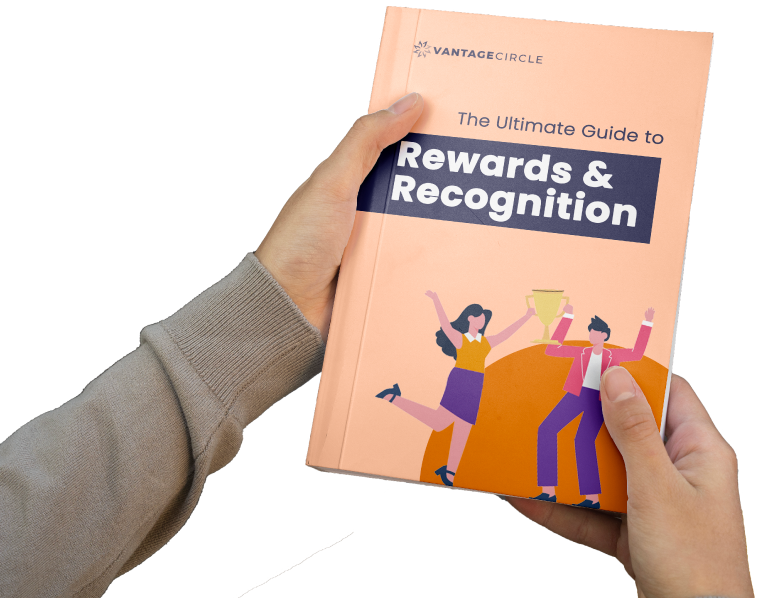Intangible Rewards: Meaning, Examples, Benefits & Best Practices
I've spent years studying what truly keeps employees engaged, and the answer often surprises companies. While competitive salaries matter, they're rarely the whole story.
Think about your own career experiences for a second -
- A thoughtful acknowledgment from leadership,
- The flexibility to balance your work and personal life,
- Opportunities to grow professionally
These moments carry no price tag yet create lasting impact. These intangible rewards tap into our intrinsic motivation, fostering a sense of purpose that financial incentives alone can't match. Unlike bonuses that provide a temporary boost, intangible rewards cultivate long-term fulfillment.
In this guide, we'll explore what intangible rewards are, why they're essential for your workforce, and how you can integrate them into your employee reward program to build a more motivated, loyal team.
Key Takeaways
- Concept of Intangible Rewards
- Examples and Benefits of Intangible Rewards
- How Intangible Rewards Impact Employee Motivation and Engagement
- Best Practices for Implementing Intangible Rewards
What Are Intangible Rewards?
Intangible rewards are non-monetary incentives that do not have any direct financial value.
We've all experienced moments when our contributions were recognized or when we were trusted with responsibilities. These instances create meaningful connections between us and our work. They reinforce our sense of purpose and belonging, ultimately driving performance and loyalty.
Key Characteristics of Intangible Rewards:
- Non-Material in Nature: They hold no direct financial component but deliver significant emotional value.
- Recognition-Based: They center on appreciation, acknowledgment, and validation.
- Long-Term Influence: They build sustained intrinsic motivation rather than temporary satisfaction.
- Employee-Centric: They're designed to make team members feel valued, respected, and engaged.
Examples of Intangible Rewards for Employees
Having worked with dozens of organizations on employee engagement, we've identified the intangible rewards that consistently make the most impact:
1. Recognition and Appreciation
A thoughtful "thank you" or public acknowledgment can profoundly impact employee morale. Recognition validates employees' efforts and motivates continued excellence.
How Employee Recognition Helps:
- Elevates morale and job satisfaction
- Nurtures a culture of appreciation and collaboration
- Strengthens emotional connection to the organization
According to a Gallup workplace survey, the most memorable recognition comes most often from an employee's manager (28%), followed by a high-level leader or CEO (24%).
For example, when leaders highlight team achievements during company meetings or on workplace platforms, it creates a ripple effect of motivation throughout the organization.

Source: Vantage Recognition
2. Career Development and Growth Opportunities
Today's professionals seek rapid career advancement. Providing learning opportunities, mentorship, and leadership roles demonstrates organizational investment in employees' futures.
According to a study by EdAssist, 84% of employees cited tuition assistance as an essential factor in joining their companies. 71% of participants rated tuition assistance among the best benefits offered by their employers after healthcare.
How Career Development Helps:
- Expands skills and professional capabilities
- Boosts employee retention and loyalty
- Empowers us to embrace new challenges
3. Work-Life Balance and Flexibility
The ability to harmonize professional responsibilities with personal needs ranks among today's most valued workplace benefits. Remote work options, flexible scheduling, or additional time off demonstrate trust and prevent burnout.
How Work-Life Balance Helps:
- Enhances mental wellbeing and productivity
- Encourages long-term organizational commitment
- Reduces workplace stress and absenteeism
Companies that implement flexible work schedules or offer occasional "work from anywhere" days show they value employees as whole people, not just workers.
Intangible Benefits Examples
Beyond specific rewards, broader intangible benefits shape the overall workplace experience. These deeper elements influence motivation, engagement, and loyalty:
1. Employee Autonomy and Empowerment
When you grant decision-making authority and ownership to employees, it fosters confidence and innovation. Being trusted leads to deeper engagement and investment in outcomes.
How Autonomy and Empowerment Help:
- Fuels creativity and problem-solving abilities
- Cultivates accountability and ownership
- Deepens job satisfaction and intrinsic motivation
2. Positive Work Culture and Team Collaboration
A supportive, inclusive workplace environment represents one of the most valuable intangible benefits. Employees thrive when they feel respected, valued, and connected to their teams.
How a Positive Work Culture Helps:
- Builds team cohesion and camaraderie
- Minimizes workplace conflict and stress
- Enhances overall job satisfaction and engagement
3. Mentorship and Professional Support
Employees engage more deeply when they have access to mentorship, coaching, and ongoing guidance. Strong mentorship programs foster career development and help them navigate challenges effectively.
How Mentorship Helps:
- Provides clear long-term career direction
- Strengthens leadership development within the organization
- Creates a sense of belonging and professional community
How Intangible Rewards Impact Employee Motivation and Engagement?
What do employees expect from their workplace? They don't simply work for compensation. They seek meaning, recognition, and growth. These intangible rewards are crucial in sustaining their engagement and organizational commitment.
To understand this better, we have to first look at the -
The Link Between Intangible Rewards and Employee Satisfaction
When employees feel valued and appreciated, they consistently demonstrate higher engagement. Recognition, development opportunities, and workplace flexibility contribute significantly to job satisfaction.
How Intangible Rewards Improve Satisfaction:
- Contributions feel meaningful
- Work becomes purposeful and fulfilling
- Workplace frustration and disengagement decrease
However, employee satisfaction through intangible rewards can only be achieved when recognition is given in adequate measure. Insufficient recognition and limited growth opportunities rank among the top reasons employees leave organizations.
That is why it is essential to use -
Intangible Rewards as a Catalyst for Retention
By implementing thoughtful intangible rewards, companies create environments where employees feel valued and motivated to stay.
How Intangible Rewards Improve Retention:
- Foster long-term organizational commitment
- Build stronger emotional connections to the company
- Reduce turnover by enhancing loyalty and engagement
LinkedIn’s Global Talent Trends report shows that 77% of companies focus on enhancing employee experience to increase employee retention.
Best Practices for Implementing Intangible Rewards in Your Organization
As we have worked with organizations across industries, we've identified key practices that separate successful implementations from failed experiments:
1. Crafting a Recognition Program Focused on Intangible Rewards
A well-structured recognition program significantly boosts morale and motivation. Effective recognition need not be elaborate, but it must be timely, specific, and authentic.
How to Create a Strong Recognition Program:
- Make it frequent and consistent: Recognition should permeate daily culture, not just mark special occasions
- Be specific and personalized: Generic praise falls flat; acknowledge exactly what impressed you and its impact
- Encourage peer recognition: Appreciation from colleagues alongside managers creates a more positive team dynamic
The most successful recognition programs I've seen make appreciation easy, immediate, and visible. You can use digital platforms or simple team rituals that celebrate contributions.

Source: Vantage Recognition
2. Balancing Tangible and Intangible Rewards for Maximum Impact
While intangible rewards drive engagement, they work best alongside tangible incentives. A balanced approach ensures employees feel valued both emotionally and financially.
How to Strike the Right Balance:
- Pair recognition with growth opportunities: Follow acknowledgment with development resources
- Complement financial rewards with non-monetary incentives: Personal time, flexible arrangements, and development opportunities often match the value of bonuses
- Customize based on individual preferences: Understand what motivates different team members
Forward-thinking organizations recognize exceptional contributions through company-wide acknowledgment, then offer opportunities to lead high-impact initiatives that further career development.
3. Encourage a Culture of Appreciation and Growth
For intangible rewards to truly succeed, they must be woven into organizational DNA rather than implemented as isolated programs. Employees should consistently feel valued, heard, and empowered.
How to Build a Rewarding Workplace Culture:
- Equip managers to provide meaningful recognition
- Foster open dialogue about career development
- Create an environment where peers appreciate each other
Conclusion: The Long-Term Value of Intangible Rewards in Employee Motivation, Engagement & Retention
As we have learned, intangible rewards aren't optional. They're essential components of a thriving, engaged workforce. Employees seek more than compensation; they desire recognition, growth opportunities, and supportive environments.
Organizations prioritizing these non-monetary rewards create cultures where team members feel valued, empowered, and motivated to excel.
While competitive compensation remains important, intangible rewards forge the emotional connections that keep employees genuinely invested. The most successful workplaces inspire, recognize, and support employees throughout their professional journeys.
So, ask yourself, "How is my organization leveraging intangible rewards to build a more engaged and motivated workforce?"


















